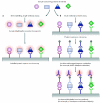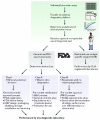Multiplexed protein measurement: technologies and applications of protein and antibody arrays
- PMID: 16582876
- PMCID: PMC1780251
- DOI: 10.1038/nrd2006
Multiplexed protein measurement: technologies and applications of protein and antibody arrays
Abstract
The ability to measure the abundance of many proteins precisely and simultaneously in experimental samples is an important, recent advance for static and dynamic, as well as descriptive and predictive, biological research. The value of multiplexed protein measurement is being established in applications such as comprehensive proteomic surveys, studies of protein networks and pathways, validation of genomic discoveries and clinical biomarker development. As standards do not yet exist that bridge all of these applications, the current recommended best practice for validation of results is to approach study design in an iterative process and to integrate data from several measurement technologies. This review describes current and emerging multiplexed protein measurement technologies and their applications, and discusses the remaining challenges in this field.
Figures



References
-
- Katus HA, et al. Enzyme linked immuno assay of cardiac troponin T for the detection of acute myocardial infarction in patients. J. Mol. Cell. Cardiol. 1989;21:1349–1353. - PubMed
-
- Mukoyama M, et al. Increased human brain natriuretic peptide in congestive heart failure. N. Engl. J. Med. 1990;323:757–758. - PubMed
-
- Laubenbacher R, Stigler B. A computational algebra approach to the reverse engineering of gene regulatory networks. J. Theor. Biol. 2004;229:523–537. - PubMed
-
- Luscombe NM, et al. Genomic analysis of regulatory network dynamics reveals large topological changes. Nature. 2004;431:308–312. - PubMed
-
- Kingsmore SF, Patel DD. Multiplexed protein profiling on antibody-based microarrays by rolling circle amplification. Curr. Opin. Biotechnol. 2003;14:74–81. - PubMed
Publication types
MeSH terms
Substances
Grants and funding
LinkOut - more resources
Full Text Sources
Other Literature Sources
Research Materials

